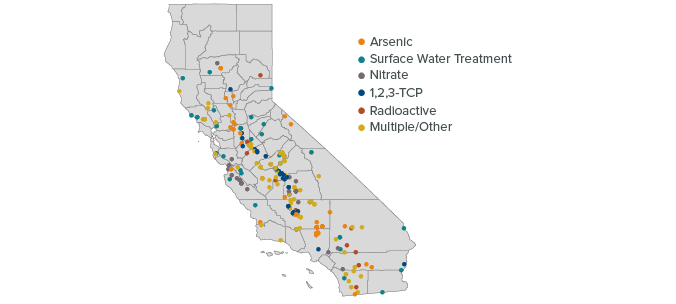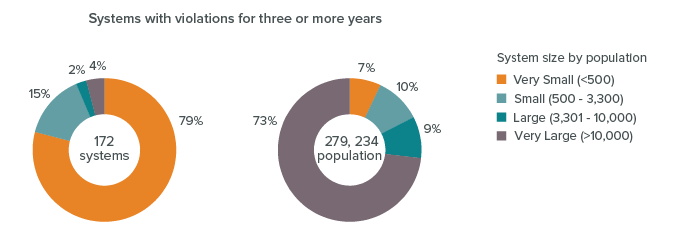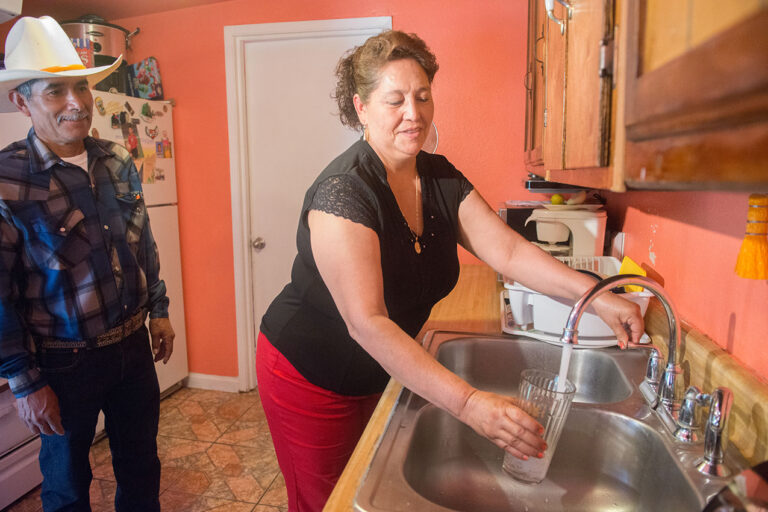- Not every Californian has access to safe and reliable drinking water.
Although most residents have safe drinking water, more than 250 water systems serving 900,000 people were out of compliance with drinking water standards in 2020. This is a chronic issue for some systems; more than 170 have been out of compliance for three or more years. More than half of these noncompliant systems are in the San Joaquin Valley—California’s largest farming region and home to a third of the state’s low-income communities. Some tribal water systems face similar challenges. A recent needs assessment by the state analyzed the water quality challenges facing roughly 1,500 very small, county-regulated water systems and more than 350,000 domestic wells across California. - Groundwater contamination is a major issue, with new contaminants emerging.
Most systems with unsafe water rely on groundwater as a primary source. Naturally occurring contaminants such as arsenic and uranium, as well as those introduced by human activity such as nitrate—mainly from nitrogen fertilizers and manure—are problems in many areas. Surface water systems sometimes encounter treatment issues that can pose health risks, but these usually can be resolved more easily than groundwater contamination. State and federal agencies continue to identify and regulate emerging contaminants. 1,2,3-TCP—a chemical that can linger in groundwater—has been regulated since 2018 and is still prevalent. Concerns are growing about the presence of widely used industrial chemicals known as PFAS in many groundwater basins, and state and federal agencies have begun coordinating to identify these hazards and set standards.
Water systems that do not meet drinking water standards are found across the state

SOURCE: Developed by the authors using data from the State Water Board’s Human Right to Water (HR2W) portal.
NOTES: The map shows the 254 community water systems (serving about 900,000 people, or 2% of the population) that HR2W reported as out of compliance in August 2020. Of the more than 400 schools with their own water systems, more than 50 were also out of compliance, as were some systems on tribal lands. Nearly 40% of community water systems had multiple violations; 21% were in violation for arsenic, and 15% for 1,2,3-TCP contamination.
- Droughts can cause drinking water shortages for some residents.
During the 2012‒16 drought at least 2,600 well-dependent households in California faced drinking water shortages, while more than 150 water systems applied for emergency state funding to address supply and quality problems. The state worked with counties and community groups to provide emergency supplies. A county drought advisory task force made up of state, local, and tribal partners has sought to use this experience to improve planning for future droughts. Groundwater sustainability agencies must also incorporate measures in their plans to mitigate the risk of wells running dry from local pumping. - Small, rural, low-income communities of color are more likely to face issues.
Almost all systems that fail to meet safety standards or lack reliable supplies are small—serving fewer than 3,300 people—and problems are most persistent in systems serving fewer than 500 people. Most of these systems are in rural, low-income communities of color. Small systems face higher costs per household to address water quality problems, because water treatment has significant economies of scale. Consumption of contaminated water can result in chronic illnesses and affect maternal health and educational outcomes. Low-income communities often experience higher rates of underlying health conditions, such as diabetes, asthma, and heart disease, which can intensify the effects of contaminant exposure. Water is often only one of many basic-service challenges that small, rural, low-income communities face.
Small systems are most likely to have chronic compliance issues

SOURCE: Developed by the authors using the State Water Board’s Human Right to Water (HR2W) portal (systems out of compliance in August 2020), and the US Environmental Protection Agency’s ECHO portal (systems chronically out of compliance, defined here as three or more years).
- Safe drinking water is a human right.
California’s Human Right to Water Act, enacted in 2012, recognizes that “every human being has the right to safe, clean, affordable, and accessible water.” Providing safe drinking water to communities affected by water contamination or shortages requires one of two things: water treatment or alternative sources of supply. Funding and partnerships are both essential. To boost state efforts to tackle these problems, the Safe and Affordable Funding for Equity and Resilience (SAFER) program was created in 2019, with $130 million annually over 10 years. Fully addressing all at-risk systems will require a major increase in funding over many years. The State Water Board has been identifying systems and allocating funding for solutions such as consolidating small water systems with larger systems, installing small treatment systems, and drilling new wells in uncontaminated locations. Progress is being made, but more work is needed to ensure all Californians have access to safe drinking water.
